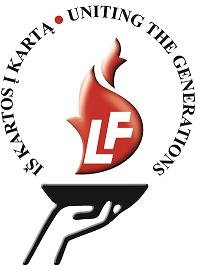Hungary
Since 2013 Budapest has a statue of the Lithuanian king of Poland and Grand Duke of Lithuania Jogaila and his Hungarian wife Hedwig of Anjou. The husband and wife sits quite apart from each other, this symbolising the age barrier that separated them. The space in-between is filled with coat of arms of Lithuania, Poland and Hungary; the monument also has the Columns of Gediminas symbol. The stature has been unveiled for the Lithaunain presidency of the European Union Council and represents a popular thought that the peacefully united Polish-Lithuanian Commonwealth was a kind of predecessor to the European Union. Moreover by adopting a Western (Catholic rather than Orthodox) form of Christianity Jogaila also set a pro-Western political momentum for Lithuania, which continues to this day. The sculpture is located near European park where every European capital had planted a tree. It had been funded by the Lithuanian government and created by Lithuanains: Dalia Matulaitė, architects Jūras Balkevičius, Rimantas Buivydas.
Despite of this however the Latin plaque on the sculpture calls the King by his Polish name Jagiello. Not only that he is called "Wladislaus Jagiello, Rex Poloniae Et Dux Supremus Lithuaniae 1386-1434" (Wladislaus Jagiello, King of Poland and Grand Duke of Lithuania 1386-1434", but he is also anachronistically called "Jagiello, Magnus Dux Lithuaniae 1377-1386" (Jagiello, Grand Duke of Lithuania 1377-1386) - even though in those days Lithuania had been his one and only realm and he was known by his Lithuanian name. Being an ethnic Lithuanian who accended to the Polish throne in his 40s Jogaila is known to have spoken Polish badly.
Since 2021, a commemorative plaque for Paulius Normantas exists in Nyíregyháza. Paulius Normantas (1948-2017) was a Lithuanian traveler, poet, and photographer who married a Hungarian woman and moved into Hungary in 1983, spending his life between his travels through Asia in Nyíregyháza. He traveled and photographed foreign cultures at the time when (due to the travel bans during Soviet occupation of Lithuania and the Soviet-ravaged Lithuanian economy) it was still rare for Lithuanians to travel, thus Normantas's works were some of the first glimpses into some remote eastern cultures from Lithuania. The plaque is located on Vaci Mihaly cultural center.





